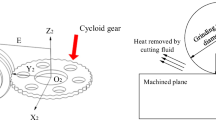Abstract
Form grinding is the finishing process of the cycloid gear of RV reducer. In order to avoid the tooth surface burn of the cycloid gear during the grinding process and improve the grinding efficiency, the heat distribution ratio and the convection heat dissipation coefficient during the grinding process are calculated. The computer simulation software ANSYS 17.0 is used to calculate the instantaneous temperature field of the tooth surface during the grinding process of the cycloid gear. The distribution of the instantaneous temperature field of the tooth surface along the axial of the gear is obtained. According to the characteristics of the YK7350B gear grinding machine, the grinding process parameters is reasonably selected, and the grinding experiment is carried out. The metallographic structure of the burned section of the experimental part was observed by the ProgRes C5 metallographic measuring instrument to verify the simulation results. The research is beneficial to predict the temperature field distribution of the tooth surface of the cycloid gear and select the grinding process parameters reasonably.








































Similar content being viewed by others
References
Stephen P, Radzevich, Krehel R (2012) Determination of the grinding wheel profile and its setup for use in finishing cylindrical gears with an evolvent profile. Int J Adv Manuf Technol 63:875–879
Wei J, Zhang G (2010) A precision grinding method for screw rotors using CBN grinding wheel. Int J Adv Manuf Technol 48:495–503
Shih Y-P, Chen S-D (2012) A flank correction methodology for a five-axis CNC gear profile grinding machine. Mech Mach Theory 47:31–45
Wang Z, Li Y, Yu T, Zhao J, Wen PH (2019) Prediction of 3D grinding temperature field based on meshless method considering infinite element. Int J Adv Manuf Technol 100:3067–3084
Su JX, Ke QX, Deng XZ, Ren XZ (2019) Numerical simulation and experimental analysis of temperature field of gear form grinding [J]. Int J Adv Manuf Technol 97:2351–2367
Jaeger JC (1942) Moving sources of heat and the temperature at sliding contacts. Proc Royal Soc New South Wales 76:203–224
Zhang L, Mahdi M (1995) Applied mechanics in grinding: IV the mechanism of grinding induced phase transformation. Int J Mach Tools Manuf 35(10):1397–1409
Guo C, Malkin S (1995) Analysis of transient temperature in grinding. J Eng Ind 117:571–577
Hahn RS (1962) The Nature of the Grinding Process. Proceeding of 3rd International Machine Tool Design and Research Conference. Birmingham, England, 43:129–154
Yang L, Wang L, Liu Q (2018) Grinding performance of a new micro-crystalline corundum wheel when form-grinding automobile gears. Int J Adv Manuf Technol 45:1514–1527
Skuratov DL, Fedorov DG Temperature fields in grinding by abrasive wheels. Int J Adv Manuf Technol 37:557–560
Wang X, Yu T, Sun X (2016) Study of 3D grinding temperature field based on finite difference method: considering machining parameters and energy partition. Int J Adv Manuf Technol 84:915–928
Malkin S (1974) Thermal aspects of grinding, part2-surface temperature and workpiece burn. J Eng Ind Trans ASME 46:484–490
Mao C (2008) Research on temperature field and thermal damage of plane grinding. Hunan University, Changsha, pp 96–97
Yong Y (2009) Finite element simulation of temperature field of ultra-high speed grinding of metal materials. Hunan University, Changsha, pp 25–29
Qingxun K (2019) Research on optimization design of grinding and machining parameters of RV reducer cycloid grinding. Henan University of Science and Technology, Luoyang, pp 30–31
Shen N, Dongjie Z, Zhongda L (2003) New handbook of metal materials. Science Press, Beijing, pp 63–203
Xiaozhong R, Hu H, Dong H et al (2015) Influence of grinding process parameters on grinding temperature of helical gear. J Henan Univ Sci Technol: Natl Sci Ed 36(3):9–13
Author information
Authors and Affiliations
Corresponding author
Additional information
Publisher’s note
Springer Nature remains neutral with regard to jurisdictional claims in published maps and institutional affiliations.
Rights and permissions
About this article
Cite this article
Su, J., Zhang, Y. & Deng, X. Analysis and experimental study of cycloid gear form grinding temperature field. Int J Adv Manuf Technol 110, 949–965 (2020). https://doi.org/10.1007/s00170-020-05832-7
Received:
Accepted:
Published:
Issue Date:
DOI: https://doi.org/10.1007/s00170-020-05832-7




